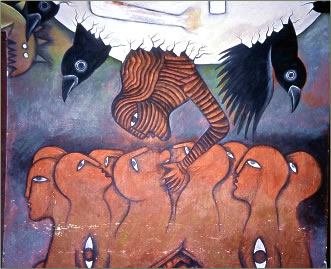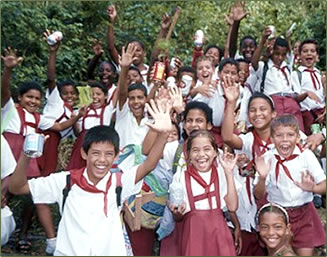


A municipal band concert in Cienfuegos brings out the locals.
By David Stanley guidebook author and independent globetrotter.
All photos courtesy of David Stanley.
On January 1, 1959, Fulgencio Batista fled Cuba as rebels led by Fidel Castro entered Santiago to declare the triumph of the Cuban Revolution. Since that time, this small Caribbean country has occupied center stage in world affairs. The United States trade embargo dates back to October 1960, and most Americans are still forbidden by their government to visit Cuba. For the rest of the world, flying to Havana is as easy as buying a ticket and lining up at the airport check-in counter.

Cocotaxis are a Cuban innovation popular with visitors.
Why travel to Cuba? While that question might provoke a smile on the face of anyone who has actually visited the country in recent years, it is a country about which many people have only limited information, and much of that misleading or out of date. My first visit to Cuba was in 1975, followed by a period of working in resorts there in the late 1970s. My most recent visit to the country was in 2004. This article offers ten reasons to consider traveling to Cuba now.

Cuba is unlike any place you’ve ever been before. The intermingling of European and African peoples and cultures has made Cuba innovative, be it in music, art, politics, or religion. The attributes of traditional West African deities have been superimposed on Catholic saints to create a new religion, santería or Cuban voodoo. Cuba is a world of its own.
 In Cuba you have a unique chance to relive 20th century history. Walk along any Cuban street and you’ll feel you’re back in the 1950s as long-tailed Chevys and Buicks glide past. Glance at the billboards extolling the revolution or note the many busy schools and clinics and you’ll see socialism in action. Cuba is the last true Communist country outside of Asia.
In Cuba you have a unique chance to relive 20th century history. Walk along any Cuban street and you’ll feel you’re back in the 1950s as long-tailed Chevys and Buicks glide past. Glance at the billboards extolling the revolution or note the many busy schools and clinics and you’ll see socialism in action. Cuba is the last true Communist country outside of Asia.
 Cuba’s museums and art galleries offer a rich feast of Spanish colonial art and architecture. The contemporary art of the revolution is striking, but it is those old palaces, churches, and cobblestone streets that attract visitors the most. Havana is ringed by powerful Spanish colonial fortresses, most of them well preserved and open to the public.
Cuba’s museums and art galleries offer a rich feast of Spanish colonial art and architecture. The contemporary art of the revolution is striking, but it is those old palaces, churches, and cobblestone streets that attract visitors the most. Havana is ringed by powerful Spanish colonial fortresses, most of them well preserved and open to the public.

Local legends in a Manuel Mendive mural, Santa Maria del Rosario.
 Havana is the largest and most remarkable city in the Caribbean. The Plaza de la Catedral dates back to the 17th and 18th centuries, while the Paseo del Prado is a classical 19th century Spanish promenade. In the hotel district of Vedado, it’s the 1950s all over again. Plaza de la Revolución is the heart of Fidel Castro’s Cuba. The ambience of Cuba’s second city, Santiago, is comparable.
Havana is the largest and most remarkable city in the Caribbean. The Plaza de la Catedral dates back to the 17th and 18th centuries, while the Paseo del Prado is a classical 19th century Spanish promenade. In the hotel district of Vedado, it’s the 1950s all over again. Plaza de la Revolución is the heart of Fidel Castro’s Cuba. The ambience of Cuba’s second city, Santiago, is comparable.
 Aside from Havana, the Spanish left a string of charming colonial towns along the length of the island. Of these the unquestioned jewel is Trinidad, unchanged in over a century. Many of Trinidad’s stately colonial mansions have been converted into guesthouses or museums, and the music in the town’s nightspots will move your feet.
Aside from Havana, the Spanish left a string of charming colonial towns along the length of the island. Of these the unquestioned jewel is Trinidad, unchanged in over a century. Many of Trinidad’s stately colonial mansions have been converted into guesthouses or museums, and the music in the town’s nightspots will move your feet.

Twin towers of Santiago de Cuba’s cathedral from the roof of Hotel Casa Grande.

Red land crabs often swarm along the dive-friendly Maria La Gorda coast to reproduce.
 The Cubans are world-class baseball players and boxers. Yet for active vacationers, the sports of choice are snorkelling, hiking and scuba diving, be it a dive on a black coral wall at Maria la Gorda or a hike across the Sierra Maestra via Cuba’s highest peak.
The Cubans are world-class baseball players and boxers. Yet for active vacationers, the sports of choice are snorkelling, hiking and scuba diving, be it a dive on a black coral wall at Maria la Gorda or a hike across the Sierra Maestra via Cuba’s highest peak.
 The Caribbean island of Isla de la Juventud to the south of Havana is Cuba in miniature. Here both the national hero Jose Marti and Cuba’s president Fidel Castro spent periods in exile. It is a largely agricultural island with secondary boarding schools built by the revolution dotting the countryside.
The Caribbean island of Isla de la Juventud to the south of Havana is Cuba in miniature. Here both the national hero Jose Marti and Cuba’s president Fidel Castro spent periods in exile. It is a largely agricultural island with secondary boarding schools built by the revolution dotting the countryside.

A school outing to the mountains on Isla de la Juventud 100 km south of Cuba’s mainland.
 Cuba’s culture is rich, especially the delightful musical melange of African rhythms and Spanish melodies. You’ll be enveloped in a salsa beat that is truly Cuban. The country’s film industry is also first class, and movies like Guantanamera and La Vida es Silbar convey Cuba’s atmosphere with unexpected brilliance. Graphic art is everywhere.
Cuba’s culture is rich, especially the delightful musical melange of African rhythms and Spanish melodies. You’ll be enveloped in a salsa beat that is truly Cuban. The country’s film industry is also first class, and movies like Guantanamera and La Vida es Silbar convey Cuba’s atmosphere with unexpected brilliance. Graphic art is everywhere.

A cigar roller at a Havana cigar factory.
 Cuba is a good place to acquire new skills. Students of all ages are welcome in the Spanish language classes offered at most universities. More informally, private Spanish tutors can be hired, though you’ll need to bring your own dictionary and textbooks. Many visitors arrange dancing lessons at cultural centers or even in nightclubs, and painting, engraving, and drumming can be studied here.
Cuba is a good place to acquire new skills. Students of all ages are welcome in the Spanish language classes offered at most universities. More informally, private Spanish tutors can be hired, though you’ll need to bring your own dictionary and textbooks. Many visitors arrange dancing lessons at cultural centers or even in nightclubs, and painting, engraving, and drumming can be studied here.

The picturesque canyon of Boca de Yumuri canyon in Guantanamo province.
 Cuba is one of the safest places in the world to visit and inexpensive for the Caribbean [though rather expensive for Latin America]. Tourism is Cuba’s largest source of income and foreign visitors are carefully sheltered from all evil, perhaps sheltered too much. The experienced traveler will find it easy to escape the resorts, and the Cuban people are sincerely friendly. It only takes one visit to realize that.
Cuba is one of the safest places in the world to visit and inexpensive for the Caribbean [though rather expensive for Latin America]. Tourism is Cuba’s largest source of income and foreign visitors are carefully sheltered from all evil, perhaps sheltered too much. The experienced traveler will find it easy to escape the resorts, and the Cuban people are sincerely friendly. It only takes one visit to realize that.
![]()
Obtaining information about Cuba’s national parks and reserves can be difficult. There’s no better place to start than Eugene Linden’s richly illustrated article, “The Nature of Cuba“, May, 2003 issue of Smithsonian Magazine.
Cuba’s best natural history book is Natural Cuba [1997] by Alfonso Silva Lee. The bilingual text is illustrated with 112 color flora and fauna photos. Birders will want to take along the Field Guide to the Birds of Cuba [2000] by Orlando H. Garrido and Arturo Kirkconnell. Cuba’s 354 species are introduced in detail.
Lonely Planet Cuba is thorough and reliable. Bicycling Cuba by Wally Smith and Barbara Smith offers detailed itineraries.
David Stanley authored the first two editions of Lonely Planet Cuba. He went on to research the South Pacific for a series of acclaimed travel guidebooks. In the early 1990s Stanley’s three editions of Eastern Europe on a Shoestring ushered Lonely Planet into Europe, and he has since written about Canada for the same company.
